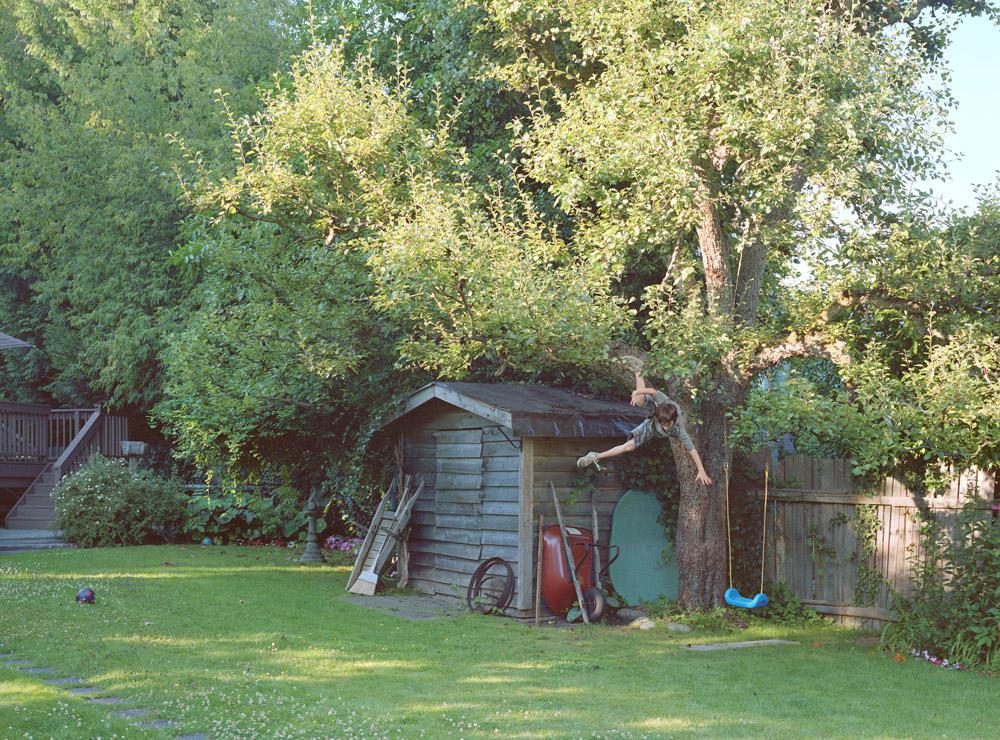There is good deal of irony in the manner in which Vancouver’s Jeff Wall presents his photograph “Invisible Man” by Ralph Ellison, the Prologue (1999–2000)—printed on a transparency and mounted on a light box. “The large-scale image is illuminated from behind by fluorescent lights, which Wall began using after seeing light-box advertisements in the late 1970s,” according to the Museum of Modern Art’s website.
In this image, Wall proves a careful student of Ellison’s 1952 novel and its anonymous narrator, who describes his subterranean home, or “hole,” as being “warm and full of light.” The figuratively invisible narrator steals from Monopolated Light & Power to illuminate his 1,369 lights. “I’ve wired the entire ceiling, every inch of it,” Ellison writes. “And not with fluorescent bulbs, but with the older, more-expensive-to-operate kind, the filament type.”
It’s not clear if Wall’s photo contains precisely 1,369 bulbs, but even if it is approximate, the ceiling is covered with lights. Yet Wall uses the very fluorescent bulbs that Ellison’s narrator sought to avoid to illuminate his transparency. Where the invisible man is trying to rack up the biggest bill he can for the Man, Wall is fine with lighting his works on the cheap.
In addition to the large scale and unique materials that Wall adopts in his work, one of his great gifts is his ability to capture a scene packed with visual information and movement in a manner that suggests that he somehow has a knack for being in the perfect place at the exact right time.
This tension between the staged and the serendipitous surfaces in many of Wall’s works, 37 of which are on exhibit through August 3 at Amsterdam’s Stedelijk Museum. “Jeff Wall: Tableaux Pictures Photographs 1996–2013” is the museum’s first major photography exhibit since it reopened in 2012 following a nine-year renovation process.
In Boy falls from tree (2010), for example, Wall has either relived the same day ad infinitum, as Bill Murray’s character did in the 1993 film Groundhog Day, and knew to stand under the tree from which the boy would plunge in an almost cruciform pose, or the scene was pre-arranged.
The same is true of Boxing (2011), which is practically grayscale with the exception of a sliver of red here and some green tints there. A living room which is a study in white doubles as the arena for a match between two sparring boys, who wear only shorts and gloves. The smaller boy throws a left-handed punch, as the one on the right leans away and raises his gloves in a defensive posture.
At first glance, the match seems impromptu, and one wants to believe that Wall has captured a moment in time—the perfect action shot. But one becomes aware that the choreography is too perfect and the composition is lined up too carefully to be haphazard.
The white orchids on the table mimic the fighters; although the group of flowers on the left bends to the left, its slope suggests a lunge toward its opponent, which backs away from the assault. And a reproduction of the British Museum’s Discus Thrower, which seems to appear on a bookcase one shelf below a Venus of Willendorf copy, also appears in mid-windup.
“Wall himself actually prefers to talk about ‘reconstructing’ his scenes rather than ‘staging’ them, in order to underline the fact that the image relates to something he has actually seen or experienced in the real world,” writes Hripsimé Visser, the Stedelijk’s photo curator, in her catalog essay. “He recreates situations and experiences, passing them through the filter of memory. Photography does not fix memories, it creates them.”
Camiel van Winkel, an art theory and philosophy instructor at LUCA School of Arts, elaborates on Wall’s process in his catalog essay. For him, Wall evokes strategies employed by 19th-century artists in the Hudson River School, who drew simple line drawings and then revisited those sketches many months or years later in an effort to “forget” the unnecessary details.
“He walks or drives around the city in which he lives. When he sees something striking, he refrains from photographing it. He lets the moment pass. Later—sometimes much later—he may decide to fabricate a reconstruction,” van Winkel writes of Wall. “The scene or event he has witnessed is then re-enacted in his studio or at a carefully selected site, under engineered conditions, with men and women engaged to ‘perform’ in front of the camera.”
Two of the women engaged to “perform” in front of Wall’s camera appear in Summer Afternoons (2013), which, according to the museum, hadn’t been shown before the exhibition opened in March. The diptych recalls some of Edward Hopper’s paintings, including A Woman in the Sun (1961) and Eleven A.M. (1926), each of which shows a nude woman in an interior space illuminated by sunlight.
In each half of Wall’s diptych, a lone nude woman lounges in a room with bright yellow walls and a deep green carpet, complemented by purple pillows and chairs. The colors are so bold that they displace the figures’ significance. But once one spots the figures, it’s difficult to parse out what exactly is occurring in the scene (again, like in Hopper’s work).
Are the figures merely resting? Are they so comfortable within their own skins that don’t mind exhibiting themselves, or is their vulnerability in their exposure? Is the viewer a voyeur, or worse, peeping Tom?
Undoubtedly, the diptych—and indeed, many of Wall’s works—double as Rorschach tests of sorts, and viewers will project their own insecurities, aspirations and other emotions onto the figures and the scenes. But one of the marks of a deep work is its ability to inspire many different people in different ways.
Menachem Wecker is a reporter based in Chicago. His trip to Holland was supported by the Netherlands Board of Tourism.









